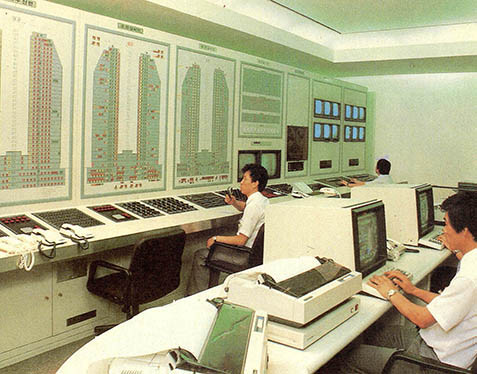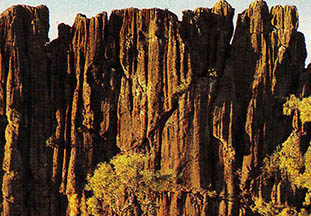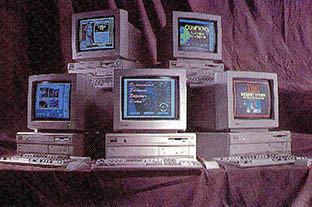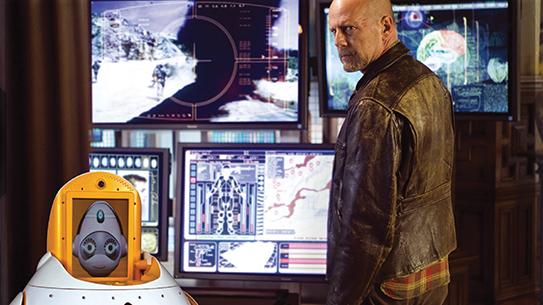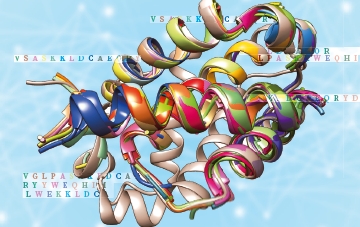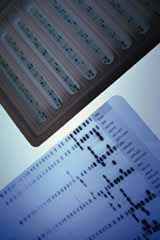The diamond is a super-substance in so many different ways that it might seem there is no possibility of a super-diamond. Nevertheless, that is what chemical engineer, William F. Banholzer, of General Electric in Schenectady, N.Y., has obtained, according to his report published in July 1990.
What makes a diamond a super-substance? What, for instance, makes it the hardest substance known?
A substance is hard when the atoms that make it up cling tightly together so that it is difficult to jar them loose by impact. Thus, when diamond is used to scratch other hard substances, atoms are jarred loose from the other substance by diamond, but nothing jars the diamond atoms loose from each other.
To make atoms stick together, each one must hook on to as many neighbors as possible. The tightest packing is where each atom hooks on to four others. The smaller the atom that hooks on in this way, the closer those atoms come to each other, and the more firmly they remain in place. The carbon atom is the smallest atom capable of hooking on to four neighbors and the diamond is made up of carbon atoms only.
Carbon atoms do not always pack together in the closet possible arrangement, however. They are loosely packed in coal, coke and soot, for instance. They are also loosely packed in graphite (the "lead" of lead pencils). However, if a piece of graphite, say, is heated to a high temperature so that the atoms can rearrange themselves, and is also put under huge pressures so that the atoms are forced as closely together as possible, the result is diamond.
Deep underground, the temperatures and pressure are high enough to produce diamond, and in a few places, such diamonds have worked their way close enough to the surface to be found. It was not until the 1950s that scientists at General Electric were able to devise methods of getting temperatures and pressures high enough(in the presence of certain metals) to get synthetic diamonds that were identical to the natural product.
Diamonds are transparent and bend the light that passes through them into myriads of rainbows. If one is cut into the proper facets, it shows flashes of different colors - "fire" - as it turns, even though it is a colorless substance. This is incredibly beautiful, and that is its chief value to people. In industry, however, its hardness makes it the best abrasive we know for rubbing down and smoothing out uneven surfaces. (There are abrasives that are cheaper and almost as good, but they are only almost as good.) Then, too, though diamond does not conduct electricity, it does conduct heat very easily. This means that the use of bits of diamond in microchips or in other miniaturized components of today's devices will keep them from overheating. In addition, of all transparent substances, diamond is least likely to be damaged by radiation, which means that it could be very useful in devices involving laser beams.
It would be nice if you could get something that conducts heat and resists radiation to an even greater extent than diamond does, but since the diamond-arrangement of atoms is the ultimate, how can you do better?
Well, there are two kinds (or "isotopes") of carbon atoms; carbon-12 and carbon-13. Every bit of carbon, including all diamonds, contains about 99 percent carbon-12 and 1 percent carbon-13.
Both types of carbon act almost precisely the same chemically, but carbon-13 is about 8 percent more massive than carbon-12, which introduces certain tiny differences. About 50 years ago, for instance, a Soviet physicist argued that when heat passes through a diamond, it does so most efficiently when all the atoms are of the same type. Even if all are carbon, the occasional carbon-13 trips up the heat energy somewhat and slows it down.
Scientists have developed ways of separating isotopes of elements and it is possible to begin with methane, a carbon-rich gas, and to treat it so that virtually all the methane molecules containing carbon-13 are eliminated. You then have methane molecules containing carbon-12 atoms only. This carbon-12 methane can then be used to make synthetic diamonds that are carbon-12 only, and this was first done by a team under Banholzer at General Electric in 1988.
Carbon-12 diamonds have now been tested by scientists at Wayne State University in Detroit and found to be super-diamonds indeed. The carbon-12 diamonds can conduct heat 50 percent better than ordinary diamonds can, and they can withstand 10 times the intensity of radiation. What was thought to have been the ultimate has been beaten!
Unfortunately, carbon-12 diamonds are even more expensive than diamonds ordinarily are, so they probably will not be used on a large scale. However, there are bound to be small-scale uses for which they will be ideal and it is quite possible they will be essential to computers and lasers of the future.
(c)1990, Los Angeles Times Syndicate
다이아몬드는 아주 여러 면에서 이미 슈퍼(초강력) 물질이므로 더욱 강한 슈퍼다이아몬드의 가능성은 존재하지 않을는지 모른다. 그러나 1990년 7월에 뉴욕주의 체넥타디에 위치한 제너럴 일렉트릭사의 화공학자인 윌리엄 밴홀저씨가 발표한 보고서는 그가 그러한 슈퍼 다이아몬드를 얻어냈다고 밝혔다.
무엇이 다이아몬드를 슈퍼물질로 만드는 것일까? 예를 들어 무엇이 과연 다이아몬드를 이제까지 알려진 물질중에서 가장 견고한 것으로 만드는 것일까? 어느 물질이 견고하다 함은 그 물질을 구성하는 원자들이 서로 꼭 달라 붙어 있어서 충격에 의하여 서로 떼어놓기가 힘들다는 것을 말한다. 따라서 다이아몬드가 다른 단단한 물질을 긁는데 사용될 때 그 물질의 원자들은 다이아몬드에 의해 삐걱대며 떨어져나가지만 다이아몬드의 원자들에게는 서로 떨어지도록 충격을 주지 못한다.
원자들이 서로 결합하려면 각 원자들이 되도록 많은 주위의 다른 원자들과 붙어있도록 해야 한다. 가장 꼭 결합되도록 하는 방법은 각 원자가 다른 네원자들과 연결되도록 하는 것이다. 이러한 방법으로 연결된 원자의 크기가 작으면 작을수록, 서로 밀착되어 있을수록, 그들은 더욱 견고하게 자기 위치를 유지하게 된다. 탄소원자는 주위의 다른 네개씩의 원자들과 밀착될 수 있는 가장 작은 원자이며 탄소원자로만 구성된 것이 바로 다이아몬드인 것이다.
그러나 탄소원자들이 언제나 서로 가장 가깝게 위치하는 배열로 결합되어 있지는 않다. 예를 들어 석탄이나 코크스나 검댕 안에서는 서로 느슨하게 붙어 있다. 또한 흑연(연필의 심)에서도 그러하다. 하지만 흑연조각을 그 구성원자들이 가능한한 서로 밀착되도록 고열로 가열시키고 또한 높은 압력을 가하면 그 결과는 다이아몬드가 된다.
땅속 깊은 곳의 온도와 압력은 다이아몬드를 만들어낼 수 있을 만큼 높으며 그렇게 만들어진 다이아몬드가 몇몇 곳에서는 인간들에게 발견될 수 있을만큼 지표에 가깝도록 솟아 나왔다. 제너럴 일렉트릭사의 과학자들이 천연다이아몬드와 똑같은 인공다이아몬드를 만들 수 있을 정도의 고열과 고압을 생성할 수 있는 방법을(다른 물질이 존재하는 환경에서) 고안해 낸 것은 1950년대에 이르러서다.
다이아몬드는 투명하며 통과하는 빛을 굴절시켜 무수한 무지개로 변환시킨다. 다이아몬드 그 자체는 무색의 물질이지만 적절한 면을 갖추도록 깎이면 "파이어"라고 불리는 다양한 색깔의 빛으로 번쩍거리게 된다. 이는 너무나 아름다워 바로 이점에 인간들이 가장 큰 가치를 부여하게 되는 것이다.
그러나 산업현장에서의 다이아몬드는 타 물체의 거친 표면을 문질러서 매끈하게 만들 수 있는 견고성 때문에 우리가 아는 최고의 연마제로 인정받고 있다.(다이아몬드의 품질에 거의 근접하도록 우수한 다른 값싼 연마제들도 있지만 비슷한 품질일 뿐 똑같지는 못하다.) 또한 다이아몬드는 전기를 전도하지는 않지만 열은 매우 쉽게 전도한다. 이는 마이크로칩이나 현대기기들이 소형부품 내에 다이아몬드 조각들을 사용함으로써 과열현상을 억제할 수 있음을 의미한다. 나아가 모든 투명물체 중에서 다이아몬드는 가장 방사선의 피해를 입지 않는 까닭에 레이저 광선과 관련되는 기기들에 유용하게 된다.
물론 다이아몬드보다 더 열전도에 좋고 방사선에 강한 어떠한 물체가 있다면 좋으리라. 그러나 다이아몬드를 형성하는 원자들의 배열이 금상첨화일진대 어찌 더 나은 물체가 가능하겠는가?
그런데 탄소원자에는 탄소-12(C-12)와 탄소-13(C-13)이라는 두 종류의 동위원소가 존재한다. 다이아몬드를 포함한 모든 탄소조각들은 99%의 C-12와 1%의 C-13을 포함하고 있다.
이 두가지 탄소는 화학적으로 거의 똑같은 작용을 한다. 그러나 C-13이 C-12보다 약 8% 무겁다는 사실은 미미하나마 그 차이를 의미하고 있다. 예를 들어 어느 소련 물리학자는 열이 다이아몬드를 통과하는 경우, 그다이아몬드의 원자가 같은 종류일 때 가장 효과적인 열의 전도가 가능하다고 주장했다. 그 원자들이 모두 탄소일지라도 가끔씩 내포된 C-13이 열에너지를 뺏고 전도의 속도를 절감시킨다는 것이었다.
그래서 과학자들은 동위체 원소들을 분리하는 방법을 개발하였고 메탄이라는 탄소함유량이 높은 가스로부터 이 작업에 착수할 수 있었다. 즉 C-13을 포함하고 있는 메탄분자들을 제거했다. 그렇게 하면 C-12 원자들만 지닌 메탄분자들을 얻을 수 있다. 이 C-12 메탄가스는 C-12 원자들만 내포하는 인공다이아몬드를 가공하는데 이용될 수 있으며, 바로 이러한 작업이 지난 1988년 제너럴 일렉트릭사에서 밴홀저씨의 연구팀에 의해 처음으로 진행됐던 것이다.
C-12 다이아몬드는 디트로이트시에 위치한 웨인 주립 대학의 과학자들에 의해 시험되었으며 바로 슈퍼다이아몬드로 판명됐다. 그 C-12 다이아몬드는 천연다이아몬드보다 50% 가량 열전도율이 높으며 10배 정도의 방사선 강도에도 견딜 수 있다. 최고라고 생각되었던 것이 무너지고 신기록이 탄생한 것이다.
안타깝게도 C-12 다이아몬드는 천연다이아몬드보다 비싸므로 광범위하게 쓰이지는 못할 것이다. 그러나 그것이 가장 적절하다고 판단되는 곳에서의 적은 규모의 이용가치는 있을 것이며, 어쩌면 미래의 컴퓨터나 레이저기기 개발에 있어 그 사용도가 절대적일 가능성이 매우 높다.
이 기사의 내용이 궁금하신가요?
기사 전문을 보시려면500(500원)이 필요합니다.
1990년 10월 과학동아 정보
🎓️ 진로 추천
- 화학·화학공학
- 물리학
- 전자공학







